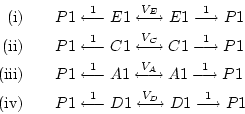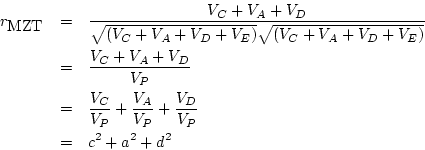so that the expected covariance between MZ twin pairs reared together
will be

Only the latter two chains contribute to the expected covariance of MZ
twin pairs reared apart, as they do not share their environment. The
expected covariance of MZ twin pairs reared apart (MZA)is thus
In the case of dizygotic twin pairs reared together (DZT), we can trace the following routes:
yielding an expected covariance between DZ twin reared together of
Similarly, the expected covariance of DZ twin pairs reared
apart (DZA)is
In deriving expected variances of
unstandardized variables, any chain from a dependent variable to an
independent variable will include the double-headed arrow from the
independent variable to itself (unless it also includes a
double-headed arrow connecting that variable to another independent
variable) and each path from an dependent variable to an independent
variable and back to itself is only counted once. In this example the
expected phenotypic variance, for all groups of relatives, is easily
derived by tracing all the paths from  to itself:
to itself:
yielding the predicted variance for P1 or P2 in Figure 5.4b
of

The equivalence between Figures 5.4a and 5.4b comes
from the biometrical principles outlined in Chapter 3:
![]() ,
, ![]() ,
, ![]() , and
, and ![]() are defined as
are defined as
![]() ,
,
![]() ,
,
![]() , and
, and
![]() ,
respectively. Since correlations are calculated as covariances
divided by the product of the square roots of the variances (see
Chapter 2), the twin correlations in Figure 5.4a
may be derived using the covariances and variances in
Figure 5.4b. Thus, in Figure 5.4b, the correlation
for MZ pairs reared together is
,
respectively. Since correlations are calculated as covariances
divided by the product of the square roots of the variances (see
Chapter 2), the twin correlations in Figure 5.4a
may be derived using the covariances and variances in
Figure 5.4b. Thus, in Figure 5.4b, the correlation
for MZ pairs reared together is
Similarly, the correlations for MZ twins reared apart, and for DZ twins together and apart are

as in the case of Figure 5.4a.